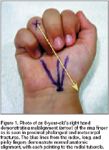Getting a grasp on hand and wrist sports injuries in children
Evaluating and treating hand and finger injuries in child athletes.

Key Points
Hand injuries are very common in young athletes, with 3% to 9% of all sports injuries involving the distal upper extremity.1 Despite this frequency, many myths associated with hand injuries in sports remain. Some of these include thoughts that motion means no fracture, that little joint injuries are little problems, and that all finger injuries require similar treatments.2 The reality is that many orthopedic complications result from a hand injury, and that misdiagnosis has the potential to result in significant long-term functional disabilities in a large number of children and young athletes.3,4 Therefore, general pediatricians need to be able to recognize and initially stabilize these injuries.
This article aims to educate pediatricians about the nature of hand and finger injuries in sports, and provide general clues for diagnosis. Common acute hand injuries that are frequently evaluated and treated by primary care physicians are discussed here, along with imaging indications, and guidelines for referral to an orthopedic surgeon or sports medicine specialist.
Pointing the way on finger injuries
Since a jam, crush, twist, or a hyperextension versus a hyperflexion mechanism will each result in a very different injury, identifying the exact mechanism of injury is essential in making the correct diagnosis. Physical examination should include careful inspection and palpation of each phalanx or finger. In some cases, focal tenderness may help localize a fracture. Joint tenderness, swelling, and/or any obvious asymmetry or deformity in a digit is concerning for a serious phalangeal injury.

As fractures and joint dislocations are very common occurrences in finger injuries, providers should have a low threshold for ordering radiographs. If indicated, appropriate views include anteroposterior (AP), lateral, and oblique views of the injured digit. If the injury is localized to one phalanx then coned down, views of that finger are preferred over radiographs of the entire hand.5